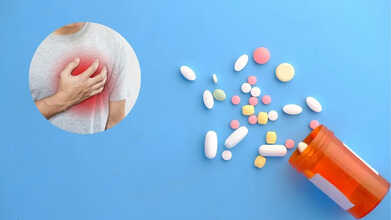- Health Conditions A-Z
- Health & Wellness
- Nutrition
- Fitness
- Health News
- Ayurveda
- Videos
- Medicine A-Z
- Parenting
- Web Stories
Being A Happy Morning Person Isn’t A Myth! Study Shows People Are Happier In The Morning

Night owls always claim that nobody can be happy waking up early! While sleeping in does feel good, morning people have a routine they must follow like getting their chores done before work, exercising etc., it almost feels like the day is longer when you wake up early. While for some people waking up early is a necessity, some others chose to enjoy an early and nice morning before they start their day! Many studies have shown that waking up early does help regulate your body and fix a lot of physical issues you may be having like fatigue, digestion etc. But does waking up early fix your mood too? Many people have noticed how morning people seem a lot more cheerful and lively than the ones who choose to sleep in as much as possible. And studies show that this isn’t a coincidence, waking up early in the morning does help lift your moods!
Sorry night owls but turns out that most people are at their happiest and most positive in the morning. Researchers found that folks generally wake up feeling pretty good, with more happiness and satisfaction about their lives. They also tend to have less of those down feelings like depression and anxiety first thing in the day. This might seem surprising since mornings are often rushed, but our bodies are naturally primed for a better mood after we wake up. It's good news, even if you're not a "morning person," your brain is likely working at its best! This research helps us understand how our feelings change throughout the day.
Connection Between The Internal Clock And Mood
The study published in BMJ Mental Health suggests that most people experience their peak mental and emotional wellbeing in the morning. While mornings are generally good, the study also found that things tend to take a turn for the worse around midnight. That's when people report feeling the least happy and satisfied, and the most anxious or down. It seems our internal clock plays a big role in our emotions. Just like we have a natural sleep-wake cycle, we also have a kind of emotional cycle that goes up and down throughout the day.
While you may think that the day of the week matters, the study shows it doesn’t have much impact on our mood, so feeling Monday morning blues is almost like you’re telling yourself to feel bad because it is Monday. Seasons, however, have a much bigger impact. Winter can be tough, with people reporting higher levels of depression, anxiety, and loneliness, and lower levels of happiness and life satisfaction. Summer, on the other hand, seems to be the best time for mental well-being. This could be because of the weather, more sunlight, or just the general feeling of summer. It's a good reminder that our mental health can be affected by this time of year.
How Did The Study Find This?
To figure all this out, researchers looked at data from over 49,000 people who took part in a study about the COVID-19 pandemic. We all know that being couped up at home for two long years did a number on people and their mental health. Researchers asked people how happy and satisfied they were, and how worthwhile they felt their lives were. The cool part is that each survey had a time stamp, so the researchers could see how people's answers changed throughout the day. This lets them track mood changes and see the morning happiness peak and the midnight low. This large-scale study gives us a really good picture of how time of day and season affects people's mental well-being.
While it may be difficult to wake up early when you first start, you don’t have to wake up at the crack of dawn, try doing it an hour earlier and move it further if you feel like it. You also have to make sure you end your day at the appropriate time and not stay awake too long because you will tire your body out quickly. To motivate yourself to do better you can also try to add activities like meditation and exercising.
Common Painkiller Tramadol Found Ineffective For Chronic Pain, May Trigger THIS Serious Health Risk

Credits: Canva
Tramadol, a strong synthetic opioid, has been commonly prescribed for moderate to severe pain. However, a recent study suggests that its risks may outweigh its modest benefits for chronic pain, and its use should be carefully reconsidered. Published in the journal BMJ Evidence-Based Medicine, the study found that tramadol may offer only a slight reduction in chronic pain, with limited evidence supporting its effectiveness.
More worryingly, it could contribute to long-term health problems that might become life-threatening. Let’s examine the study’s findings in detail.
What Is Tramadol Used For?
Tramadol is a prescription, only synthetic opioid used to manage moderate to severe pain. It works by changing how the brain and nervous system perceive pain, according to Medline Plus. Its uses include:
- Acute pain: Immediate-release formulations help manage short-term, intense pain, such as after surgery or an injury.
- Chronic pain: Extended-release tablets and capsules are used for persistent, severe pain when other treatments have failed.
- Condition-specific pain: It may be prescribed for ongoing pain from conditions such as osteoarthritis, fibromyalgia, and neuropathic pain.
Tramadol Can Lead To Serious Health Issues?
A new review suggests that millions of Americans with chronic pain may be prescribed tramadol, a drug that may provide minimal relief. Even more concerning, the research highlights that the medication could increase the risk of serious health complications, including heart disease, the leading cause of death in the US.
According to the Centers for Disease Control and Prevention, about 51.6 million adults in the US, roughly one in five, experience chronic pain, with 17.1 million having pain that interferes with daily life or work. Tramadol has often been used to manage this pain, with 16 million prescriptions written for the drug in 2023 alone. Traditionally seen as a “safer alternative” to stronger opioids, tramadol has been perceived to carry fewer side effects and a lower risk of addiction.
Given conflicting evidence from earlier limited studies, Danish researchers decided to evaluate whether tramadol is truly effective and safe for chronic pain. “The findings suggest that the benefits of tramadol are questionable or uncertain. Additionally, there is evidence of potentially harmful effects,” said Dr. Janus Jakobsen, lead author and clinical professor at the University of Southern Denmark.
Tramadol Side Effects
Tramadol can cause serious side effects, including heart-related issues such as chest pain, heart disease, or congestive heart failure. The study also found it increased the risk of both mild and serious adverse events, including nausea, dizziness, constipation, drowsiness, and cardiac complications. It may also be linked to neoplasm events, abnormal cell growths that can lead to tumors, which may be benign or malignant.
These findings, published in BMJ Evidence-Based Medicine, arrive amid the ongoing opioid crisis in the US, which has claimed hundreds of thousands of lives since the late 1990s. Research indicates that around 12% of patients treated with opioids for chronic pain may develop addiction or misuse the drugs, raising the risk of overdose and other severe outcomes.
The opioid epidemic was declared a national public health emergency by President Trump in 2017, and the death toll has continued to rise in the years since.
10 Sleep Truth That May Be Holding You Back From Proper Rest, Sleep Doctor Reveal Harsh Sleep Truths

(Credit-Canva)
A major part of your health depends on your sleep. While you may delay your sleep or skip it to do other tasks, your body keeps the score. You may be slowly pushing yourself into not just physical health issues, but also mental health issues.
While sleep may seem like an easy thing, you only need enough time for there are many aspects of it that could reveal whether you are sleeping well or not. In a recent post, Dr Christopher J Allen, MD, a US board-certified sleep doctor, revealed 10 important sleep facts that one must know.
Sleep Advice You Need For Proper Rest
In the video titled, “Advice I’d give you as a sleep doctor for a decade – If I wasn’t afraid of hurting your feelings” he gave the below mentioned advice.
Snoozing Doesn't Help
Hitting the snooze button actually confuses your brain. It starts a new sleep cycle that you immediately interrupt. This guarantees you will feel more groggy and tired all morning, not rested. Just get up when the alarm first rings.
Late-Night Energy Isn't Natural
Feeling "wired" late at night isn't natural energy. It usually means you've had too much stimulation, you're dehydrated, and you're stuck in a constant stress cycle. Your body is running on high alert, not true fuel.
Instant Sleep Isn't Healthy
If you fall asleep the second your head hits the pillow, you don't have great sleep; you have a problem. It's a clear sign of severe exhaustion or a major sleep debt built up from missing sleep over time.
You Need Recovery, Not Stimulants
Your constant low energy can't be fixed by simply drinking more caffeine. Your real issue is a lack of proper recovery. You need more REM sleep—the deep, restorative kind—to truly solve your energy problem.
Midnight Waking Is Stress-Related
Waking up sharply at 3 AM is not random bad luck. It often happens because your stress hormones, called cortisol, start pumping during the night. Your body is on high alert, starting its "night shift" while you should be resting.
Scrolling Isn't Relaxing
You think you're relaxing when you scroll through your phone, but your nervous system disagrees. The bright screen and constant stimulation signal danger to your brain, putting you into survival mode instead of calming you down.
Weekend Catch-Up Doesn't Work
Trying to "catch up" on sleep during the weekend doesn't fix your sleep debt. It simply throws off your body's internal clock (circadian rhythm). This actually makes it much harder to wake up and start your week on Monday.
You Can't 'Get Used To' 5 Hours
Science shows that believing you are "used to" only five hours of sleep is dangerous. Your body is actually quietly suffering damage and breaking down. You need more sleep to avoid long-term health risks.
Tiredness Starts Before Bed
Waking up feeling completely exhausted isn't usually your mattress's fault. It’s often connected to your stress mindset, the food you eat, and those sneaky stress hormone spikes that happen while you should be deeply sleeping.
Most Important Factor For Sleep
The health expert ended the post by explaining your body can't truly heal and recover if you keep it in the same environment and under the same stress that makes you feel run down. Your bedroom and your nightly routine are actually a direct reflection of your entire lifestyle.
The core scientific truth is that your body isn't being lazy, it is genuinely exhausted, and your brain isn't broken, it's just begging for the safety and security that comes from good, proper rest.
Feeling Anxious Lately? Experts Reveal How It Might Be Affecting Your Blood Pressure

Credits: Canva
According to India’s National Mental Health Survey, nearly 3.5% of the country’s population experiences anxiety disorders each year, often triggered by work stress, relationship problems, or distressing events. While mild anxiety is a normal part of life, persistent or unmanaged anxiety can keep older adults in a constant state of tension.
This long-term stress may increase heart rate, affect mood, and, as experts now warn, even raise blood pressure (BP). The American Psychological Association (APA) defines anxiety as ongoing feelings of worry or unease that can cause physical reactions such as a faster heartbeat or sweating.
The APA also notes that anxiety can temporarily elevate blood pressure. In turn, people with chronic high blood pressure, or hypertension, may develop anxiety about their health, creating a cycle where each condition worsens the other.
Can Anxiety Lead To Blood Pressure?
Anxiety is the body’s built-in response to stress. It’s common to feel anxious before a major exam or while awaiting important news. When this happens, the body releases stress hormones that raise the heart rate and narrow blood vessels, both of which can push blood pressure higher.
A 2015 study by Medical News Today found that individuals with severe anxiety faced a greater risk of developing hypertension compared to those with milder symptoms. Researchers emphasized the importance of early diagnosis and treatment of anxiety, especially for people who already have high blood pressure.
In most cases, anxiety-related spikes in blood pressure are short-lived and return to normal once the person calms down. However, constant anxiety can strain the heart, kidneys, and blood vessels much like long-term hypertension does. Over time, hormonal changes linked to anxiety may lead to fat accumulation, especially around the waist. Anxiety can also alter daily habits, such as causing stress eating, which may indirectly raise blood pressure.
Signs of Anxiety-Induced High Blood Pressure
A normal blood pressure reading typically falls between 90/60 mmHg and 120/80 mmHg. For adults over 80, readings below 150/90 mmHg are considered healthy. When readings consistently rise above these levels, it can indicate hypertension. Some anxiety medications can also increase blood pressure. For example, serotonin and noradrenaline reuptake inhibitors (SNRIs), commonly used to treat anxiety disorders, are known to cause a rise in BP. Common symptoms of anxiety that may contribute to higher blood pressure include:
- Trembling or shaking
- Excessive sweating
- Chest pain
- Headaches
- Nausea or stomach discomfort
- Irritability
- Dizziness or shortness of breath
Can High Blood Pressure Also Trigger Anxiety?
High blood pressure itself can sometimes lead to feelings of anxiety. People diagnosed with hypertension may start worrying about their long-term health or potential complications. The symptoms of hypertension, such as headaches, vision problems, or an irregular heartbeat can also cause distress or panic. According to Medical News Today, signs of hypertension can include:
- Vision changes
- Headaches
- Irregular heart rhythm
- Buzzing in the ears
Severe hypertension can also provoke anxiety. If someone feels unusually anxious and experiences symptoms like headaches or shortness of breath, it is important to seek immediate medical help.
Since hypertension often develops without clear warning signs, it can be difficult to tell whether the cause of discomfort is anxiety or high blood pressure. This is why regular check-ups with a doctor are essential for monitoring and managing both conditions effectively.
© 2024 Bennett, Coleman & Company Limited




